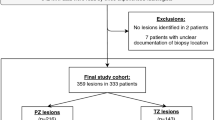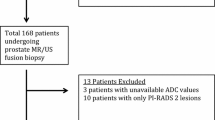Abstract
Purpose
To assess the diagnostic accuracy of PI-RADS v2 categories ≥ 3 to detect clinically significant prostate cancer (csPCa) against histopathology of Transperineal Mapping Biopsy (TPMB).
Materials and methods
IRB-approved retrospective cohort study included 47 men who had 3.0 T multi-parametric MRI (mpMRI) and TPMB of prostate. Two radiologists independently evaluated T2, DWI, ADC map, and DCE images using PI-RADS v2 categories. A third radiologist served as tie-breaker. PI-RADS v2 score (PS) ≥ 3 lesions were correlated with 3D model of TPMB (3DTPMB) results based on prostate sectors. Two groups of csPCa status were separately analyzed for accuracy measures at lesion and person levels: Group 1 with GS (Gleason Score) ≥ 7 and group 2 with tumor volume ≥ 0.5 cc. Inter-rater reliability for PS and MR lexicon was calculated.
Results
Forty-seven patients with 3DTPMB had at least one lesion with PS ≥ 3 on mpMRI. PS of 5 had high PPV and high specificity of 100% at the lesion and person levels. Sensitivity of a PS ≥ 3 was 68.27% for group 1 and was 48.39% for group 2. Specificity was 93.56% for group 1 and was 95.53% for group 2. At the person level, sensitivity of PS ≥ 3 was 81.25% for group 1 and was 82.35% for group 2. Specificity was 32.26% for group 1 and was 53.85% for group 2.
Conclusion
PI-RADS v2 category of 5 had high PPV and specificity; however, combined PS ≥ 3 had mixed performance in detection of csPCa.


Similar content being viewed by others
References
Key Statistics in Prostate Cancer. https://www.cancer.org/cancer/prostate-cancer/about/key-statistics.html. Accessed 15 Jan 2017
Cancer of the Prostate - Cancer Stat Facts [Internet]. https://seer.cancer.gov/statfacts/html/prost.html. Accessed 13 Sept 2017
Weinreb JC, Barentsz JO, Choyke PL, et al. (2016) PI-RADS prostate imaging - reporting and data system: 2015, version 2. Eur Urol. 69(1):16–40
American College of Radiology. MR Prostate Imaging Reporting and Data System version 2.0. http://www.acr.org/Quality-Safety/Resources/PIRADS/. Accessed 15 Jan 2017
Fulgham PF, Rukstalis DB, Turkbey IB, et al. (2017) AUA policy statement on the use of multiparametric magnetic resonance imaging in the diagnosis, staging and management of prostate cancer. J Urol. 198(4):832–838
Spilseth B, Ghai S, Patel NU, et al. (2017) A comparison of radiologists’ and urologists’ opinions regarding prostate MRI reporting: results from a Survey of Specialty Societies. American Journal of Roentgenology. https://doi.org/10.2214/AJR.17.18241
Polanec S, Helbich TH, Bickel H, et al. (2016) Head-to-head comparison of PI-RADS v2 and PI-RADS v1. Eur J Radiol. 85(6):1125–1131
Cash H, Maxeiner A, Stephan C, et al. (2016) The detection of significant prostate cancer is correlated with the Prostate Imaging Reporting and Data System (PI-RADS) in MRI/transrectal ultrasound fusion biopsy. World J Urol. 34(4):525–532
Muller BG, Shih JH, Sankineni S, et al. (2015) Prostate cancer: interobserver agreement and accuracy with the revised Prostate Imaging Reporting and Data System at multiparametric MR imaging. Radiology. 277(3):741–750
Purysko AS, Bittencourt LK, Bullen JA, et al. (2017) Accuracy and interobserver agreement for prostate imaging Reporting and Data System, version 2, for the characterization of lesions identified on multiparametric MRI of the prostate. AJR Am J Roentgenol. 209(2):339–349
Baldisserotto M, Neto EJD, Carvalhal G, et al. (2016) Validation of PI-RADS v. 2 for prostate cancer diagnosis with MRI at 3T using an external phased-array coil. J Magn Reson Imaging. 44(5):1354–1359
Cash H, Günzel K, Maxeiner A, et al. (2016) Prostate cancer detection on transrectal ultrasonography-guided random biopsy despite negative real-time magnetic resonance imaging/ultrasonography fusion-guided targeted biopsy: reasons for targeted biopsy failure. BJU Int. 118(1):35–43
Hansen NL, Kesch C, Barrett T, et al. (2017) Multicentre evaluation of targeted and systematic biopsies using magnetic resonance and ultrasound image-fusion guided transperineal prostate biopsy in patients with a previous negative biopsy. BJU Int. 120(5):631–638
Crawford ED, Rove KO, Barqawi AB, et al. (2013) Clinical-pathologic correlation between transperineal mapping biopsies of the prostate and three-dimensional reconstruction of prostatectomy specimens. Prostate. 73(7):778–787
Dimmen M, Vlatkovic L, Hole K-H, et al. (2012) Transperineal prostate biopsy detects significant cancer in patients with elevated prostate-specific antigen (PSA) levels and previous negative transrectal biopsies. BJU Int. 110(2 Pt 2):E69–E75
Barqawi AB, et al. (2011) The role of 3-dimensional mapping biopsy in decision making for treatment of apparent early stage prostate cancer. J Urol 186(1):80–85
Ploussard G, Epstein JI, Montironi R (2011) The contemporary concept of significant versus insignificant prostate cancer. Eur Urol. 60(2):291–303. https://doi.org/10.1016/j.eururo.2011.05.006
Grey ADR, Chana MS, Popert R, et al. (2015) Diagnostic accuracy of magnetic resonance imaging (MRI) prostate imaging reporting and data system (PI-RADS) scoring in a transperineal prostate biopsy setting. BJU Int. 115(5):728–735
Arumainayagam N, Ahmed HU, Moore CM, et al. (2013) Multiparametric MR imaging for detection of clinically significant prostate cancer: a validation Cohort Study with transperineal template prostate mapping as the reference standard. Radiology 268(3):761–769
Zhang L, Tang M, Chen S, et al. (2017) A meta-analysis of use of Prostate Imaging Reporting and Data System Version 2 (PI-RADS V2) with multiparametric MR imaging for the detection of prostate cancer. Eur Radiol. 27:5204
Seo JW, Shin S-J, Taik OhY, et al. (2017) PI-RADS version 2: detection of clinically significant cancer in patients with biopsy gleason score 6 prostate cancer. AJR Am J Roentgenol. 209(1):W1–W9
Vargas HA, Hötker AM, Goldman DA, et al. (2016) Updated prostate imaging reporting and data system (PIRADS v2) recommendations for the detection of clinically significant prostate cancer using multiparametric MRI: critical evaluation using whole-mount pathology as standard of reference. Eur Radiol 26:1606. https://doi.org/10.1007/s00330-015-4015-6
Rosenkrantz AB, Ginocchio LA, Cornfeld D, et al. (2016) Interobserver reproducibility of the PI-RADS version 2 lexicon: A Multicenter Study of six experienced prostate radiologists. Radiology. 280(3):793–804
Acknowledgments
The authors gratefully acknowledge Dr. Nelson N. Stone, MD (Professor of Urology and Radiation Oncology, The Icahn School of Medicine at Mount Sinai New York), Alexandria Jensen, Dr. Francisco La Rosa, Emma Murugaverl, Paul Arangua, and Francisco G. La Rosa (all with the University of Colorado School of Medicine) for their insight and assistance with this project.
Author information
Authors and Affiliations
Corresponding author
Ethics declarations
Funding
Dr. Sajal Pokharel had received a pilot Grant from the department of radiology at University of Colorado. No other grant funding.
Conflict of interest
Dr. Nayana Patel, Dr. Kimberly Lind, Dr. Kavita Garg, Dr. David Crawford, and Dr. Priya Werahera declare that they have no conflict of interest.
Rights and permissions
About this article
Cite this article
Patel, N.U., Lind, K.E., Garg, K. et al. Assessment of PI-RADS v2 categories ≥ 3 for diagnosis of clinically significant prostate cancer. Abdom Radiol 44, 705–712 (2019). https://doi.org/10.1007/s00261-018-1751-5
Published:
Issue Date:
DOI: https://doi.org/10.1007/s00261-018-1751-5




